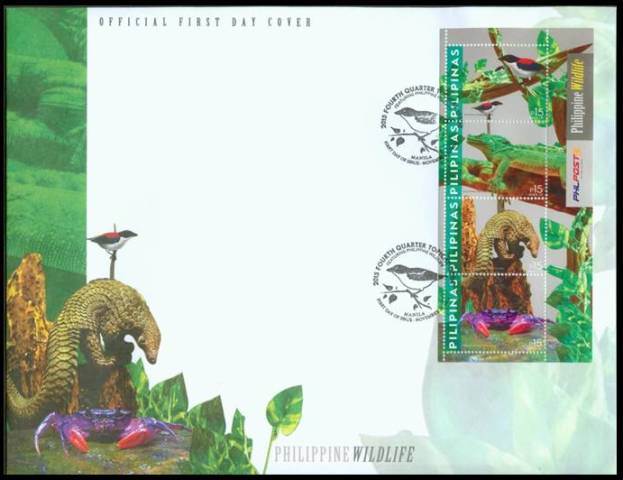2015, November 11. Philippine Wildlife
Litho Offset, Amstar Company, Inc., Perf 14
Se-tenant Strips of 4, Miniature Sheets of Four Different Stamps

Se-tenant Strips of Four (30,000)
15p Vizayas Flowerpecker
15p Philippine Sail-fin Lizard
15p Philippine Pangolin Anteater
15p Freshwater Purple Crab
Miniature Sheets of Four (30,000)
Layout Artist: Rodine C. Teodoro
First Day Covers: Manila
WILDLIFE OF THE PHILIPPINES
Visayan Flowerpecker (Dicaeum haematostictum). This species is listed as Vulnerable because its population is believed to have declined rapidly as a result of extensive forest clearance. It is projected that continued habitat loss will cause future rapid declines in its population and range. Dicaeum haematostictum is endemic to the Western Visayas in the Philippines (Collar et al.1999). Formerly widespread and common on Negros at least, it appears to have undergone a steep decline, with surprisingly few recorded during recent surveys, although it was reportedly abundant around Mt Talinis in 1991-1992, and was recorded at Simpang Forest, Sipalay in 2005 (J. Hornbuckle per A. Bucol in litt. 2007), with records from multiple sites in 2011 (per D. Allenin litt. 2012). Its status on Panay is unclear. Despite a number of recent records, no birds were recorded from Mt Madja-as during a month of fieldwork in 1991. It is presumed extinct on Guimaras, although this requires verification.
Philippine Sailfin Lizard (Hydrosaurus pustulatus). Sailfin lizards are the ecological equivalent of the Australian water dragon. Their days are spent in vegetation overhanging the rivers and streams of the tropical jungles of the Philippine Islands, dropping into the water and swimming to the bottom at the first sign of approaching danger. They are excellent swimmers and their tail is flattened sideways to provide more propulsion through the water. Sailfins are omnivores, meaning they eat a wide variety of plant material, such as leaves, shoots, fruits, etc., supplemented with the occasional insect or crustacean.
Philippine Pangolin Anteater (Manis culionensis). Pangolins, often called “scaly anteaters,” are covered in tough, overlapping scales. These burrowing mammals eat ants and termites using an extraordinarily long, sticky tongue, and are able to quickly roll themselves up into a tight ball when threatened. Poaching for illegal wildlife trade and habitat loss have made these incredible creatures one of the most endangered groups of mammals in the world.
Freshwater Purple Crab. Four new species of crab that sport some wild colors have been discovered near the Philippine island of Palawan. The newfound species are threatened by mining activities in the region, which is one of the world's major biodiversity hotspots. About half of the species that live on Palawan are endemic, meaning they are found nowhere else. Scientists at the Senckenberg Research Institute in Germany and De La Salle University in Manila found the four new species of Insulamon freshwater crab genus as part of their Aqua Palawana research program. The reddish-purple crabs are the only varieties that are endemic to only one or a few islands; the sea keeps them from spreading further, as they depend on freshwater at all stages of their development. Having been completely separated from their relatives, they have developed their own separate species and genera over tens of thousands of years.
-
Animals
-
Wildlife
